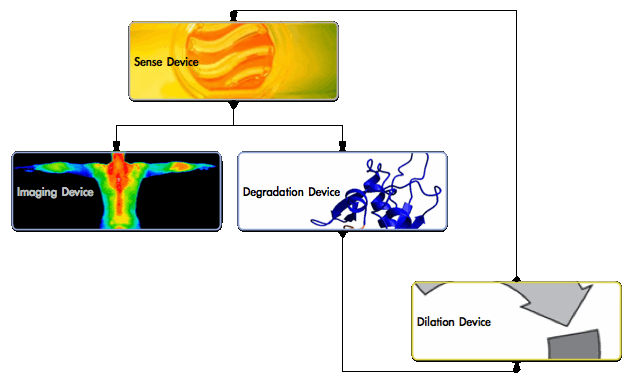Team:NTU-Singapore/Project/Prototype
From 2009.igem.org
| Line 26: | Line 26: | ||
<div class="grid_11 suffix_1 omega"> | <div class="grid_11 suffix_1 omega"> | ||
| - | <span class="title">Our <span class="bold"> | + | <span class="title">Our <span class="bold">Prototype</span></span><br class="clear" /> |
| Line 144: | Line 144: | ||
| - | === System | + | === System Modelling === |
| - | So now we have designed a coherent '''system''' complete with '''devices''' with specific objectives and '''parts''' with well-defined gene sequences. | + | So now we have designed a coherent '''system''' complete with '''devices''' with specific objectives and '''parts''' with well-defined gene sequences. Now let's analyze our system theoretically and mathematically using models. |
| - | + | ||
| - | + | ||
| - | + | ||
Revision as of 14:19, 19 October 2009
Our Prototype
In the Research Proposal, we identified the gene sequences of interest that will allow us to build our prototype system.
Now we can start to design our system from the ground up, starting with arranging parts into devices.
We can also begin to construct a top-down modelling schema to simulate our system!
Prototype System Design
Recall the construct layout for the ideal system earlier. Our prototype will utilize a similar layout.
We will now elaborate on the rationale of their placement in each device.
Sense device
- Arguably the most important gene sequence, we have decided to use the NO-sensitive promoter region of the NorV/W gene sequence endogeneous in E.Coli.
- This NO-sensitive promoter (we will refer to it as pNO henceforth) will be the active NO-sensor for our system.
- pNO is ON in high [NO] conditions & OFF in low [NO] conditions.
- This NO-sensitive promoter (we will refer to it as pNO henceforth) will be the active NO-sensor for our system.
- The pNO will be placed upstream of a TetR gene sequence. TetR is used to repress the other devices.
- The rationale here is that in healthy [NO] condition, pNO is activated and will facilitate expression of TetR.
- In low [NO] conditions, pNO will be deactivated and the transcription of TetR gene sequence will stop. Hence repression of other devices will stop.
Degradation device
- As mentioned above, the pTet promoter will serve as the controller for this device.
- In high [TetR] conditions, implying high [NO] conditions, Degradation device is OFF. In low [TetR], implying low [NO] conditions, this device will be ON.
- LuxI gene sequence expresses LuxI protein.
- LuxI protein catalyzes conversion of SAM protein to AHL.
- pLacIQ is constitutively ON.
- This means that downstream LuxR gene sequence is constitutively transcribed.
- LuxR gene sequence produces LuxR.
- LuxR binds with AHL in low [NO] conditions and subsequently activates pLuxR.
- pLuxR logically is only activated when [TetR] is low.
- This also means pLuxR is only ON in low [NO] conditions.
- CHE gene sequence will express Cholesterol Esterase enzyme.
- This enzyme will breakdown the cholesteryl esters in plaque.
Imaging device
- Again, pTet regulation will control the activation/repression of this device.
- System is only ON at low [NO] and OFF at high [NO].
- The Heme-Oxygenase 1 gene sequence (HO-1) and Infrared Protein gene sequence (IFP) are to be considered coupled.
- HO-1 expression will facilitate the conversion of heme to biliverdin.
- IFP, a protein discovered by Tsien lab, requires bilverdin to be stable and fluoresce in the infra-red spectrum.
Dilation device
The Dilation device is special because it features a "delay" mechanism endemic to E.Coli. This delay mechanism will be replaced with a mammalian counterpart if designing the actual mammalian biological system.
- The Dilation device features constitutive transcription of LuxR gene sequence.
- [LuxR] will repress the activation of pLuxR further downstream.
The following is our E.Coli delay mechanism.
- pLuxR is activated when LuxR is removed by selective binding to AHL.
- This is where the LuxI from the Degradation device comes in.
- LuxI converts SAM protein to AHL. AHL binds to LuxR. We expect this series of binding comes with a time lag.
- Recall that Degradation device is only ON at high [NO] conditions.
- Hence pLuxR is only activated at high [NO] conditions, and only after a lag period.
- This is where the LuxI from the Degradation device comes in.
- Activated pLuxR allows for transcription of Nitric Oxide Synthase [NOS].
- NOS will then regenerate [NO] at plaque site.
System Modelling
So now we have designed a coherent system complete with devices with specific objectives and parts with well-defined gene sequences. Now let's analyze our system theoretically and mathematically using models.
Literature / References
Please proceed here to view our full list of references.
 "
"




